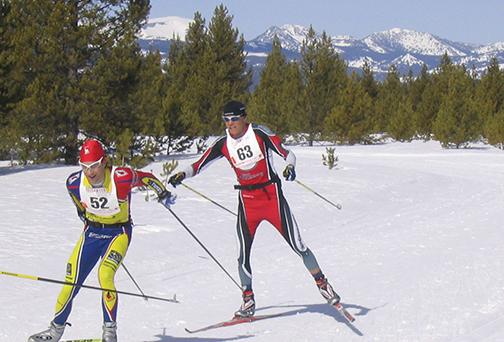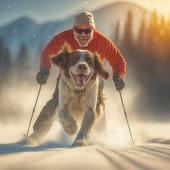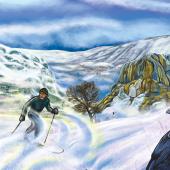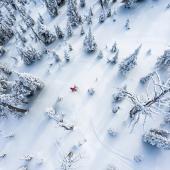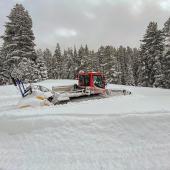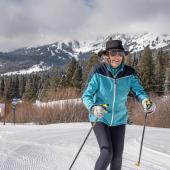A Moveable Feast
Nordic skiing near the Park.
“There’s no other place like this. I mean, where can you ever go knee-deep in powdery snow in November?” says Urban Sandel, a Swedish student at Minnesota State University. “I’d never miss such an occasion.” Sandel is talking about West Yellowstone, and he’s not the only person to think in these terms. Nor is he the only person to drive across the country to hit the immaculate slopes. In fact, multitudes of people from everywhere attend the annual ski festival to inaugurate the West Yellowstone cross-country ski season. And they do it with trunkfulls of grub hauled from home, as the Yellowstone Ski Festival seems as much about food as skiing.
The “skiing high” here is beyond words. West Yellowstone is known for its early-season snow and is often the first Nordic ski area in North America to start grooming trails. Last year’s Yellowstone Ski Festival conditions were sublime: velvety, perfectly groomed snow in the morning and new, fabulous, white powder each afternoon. At the lodges around town, tireless skiers continued the feast in the evenings, sharing their generous gastronomic efforts carried from home. Great skiing, good food, wine, and camaraderie; that’s what the festival is all about. The event, which traditionally takes place every year around Thanksgiving, is indeed a reason to give thanks.
THE RENDEZVOUS SYSTEM
Easily accessible from downtown West Yellowstone and perched at over 6,800 feet, the Rendezvous ski trail system consists of over 21 miles of gently-rolling, beautifully groomed trails that wind through lodgepole pine and open meadows. It provides perfect conditions for high-altitude training and recreation year round. The altitude and proximity to the Continental Divide also means that snow comes early and stays late.
“West Yellowstone is a place where cross-country skiing is very important,” explains Jamie Greene, festival coordinator. “From Maine to Alaska, Nordic skiers pay attention to what’s going on with our snow conditions early in the fall.” Greene admits that she too starts getting anxious around the middle of October. “With the affluence of cross-country skiers, the whole season really depends on how much snow we get starting mid-October,” she says. “As soon as we have four inches on the ground, we start skiing.”
Seven international teams have used the Rendezvous trail system to prepare themselves for the Olympics. Most of the 2006 U.S. Olympic team—including Kris Freeman, Wendy Wagner, Andy Newell, and Abbi Larson—has attended the festival in years past. In 2005, ski teams from Middlebury, the University of New Mexico, the University of Alaska, MSU, the University of Minnesota, and Whitman College all kicked off their ski seasons in West Yellowstone. Biathletes also attend in large numbers; the Rendezvous shooting range is considered one of the best in the country.
BACK IN THE DAY
Skiing in West Yellowstone dates back more than a century when U.S. cavalry soldiers patrolled Yellowstone National Park on skis they called “agony boards.” Early explorers and trappers also used skis to travel through this immense mountain valley. In 1908, the Union Pacific Railroad put the town on the map as an easily accessible Park entrance. Summer tourism boomed, but when snow closed mountain passes and shut down rail travel, West Yellowstone was a world unto itself. And it still is. Skiers find solitude in the backcountry when the rest of the trails are bustling with races and team training—though the trail system’s vastness means you can usually get away from crowds just about day of the week.
This inimitable ski trail system was born 30 years ago when a West Yellowstone couple, Neal and Grace Swanson, wanted to create a local area where their sons and their friends could ski. Skiing on groomed trails was getting popular, and Gallatin National Forest officials allowed the family to groom old logging roads that began at the south edge of town. The first grooming equipment consisted of a snowmobile pulling a pair of ski separated by a metal bar, weighted by concrete blocks.
The Swanson boys and their friends, Olympic medalist Bill Koch, and Olympic racer Audun Endestad first began skate skiing on the Rendezvous trails in the winter of 1980-81. Skate skiing requires broad sweeps in smooth, packed snow, much like ice skating. Koch used this revolutionary technique to take the cross-country world by storm. The technique required a new trail grooming method, and soon the Rendezvous had a track for traditional (now referred to as “classic”) technique alongside a wide lane for skate skiing. Nowadays, skate-skiers often outnumber classic skiers by as much as 10 to 1.
YOUR OWN RENDEZVOUS
If you decide to attend the festival this year, you’ll be glad to know that plenty of lodging choices exist, and many lack the high-dollar price tag of the main summer and winter seasons. The town also has cool shops, including Freeheel and Wheel, a hip little all-purpose store where you can gear up, buy your Rendezvous pass, enjoy some warm homemade food, and sip tasty lattes.
This year’s festival, November 21-25, will feature the annual Fall Nordic Ski Camp, as well as manufacturers, exhibits, wax clinics, and racing events. The clinics, which are coached by former Olympic athletes and lifelong Nordic skiers, vary in length and fees, and everyone is welcome. According to Greene, kids’ clinics will be added this year. If you’re interested in a clinic, be sure to get signed up early. “We’ve had ski clinics for 25 years where people have improved their techniques or learned from zero,” explains Greene. “We have a capacity of about 220 people, and if we have a good snow year we may have 3,000 skiers around here.”
Unless you’re headed to Norway soon, West Yellowstone is the best place to bring your skis (and your turkey) next Thanksgiving. For more info visit yellowstoneskifest.com.

